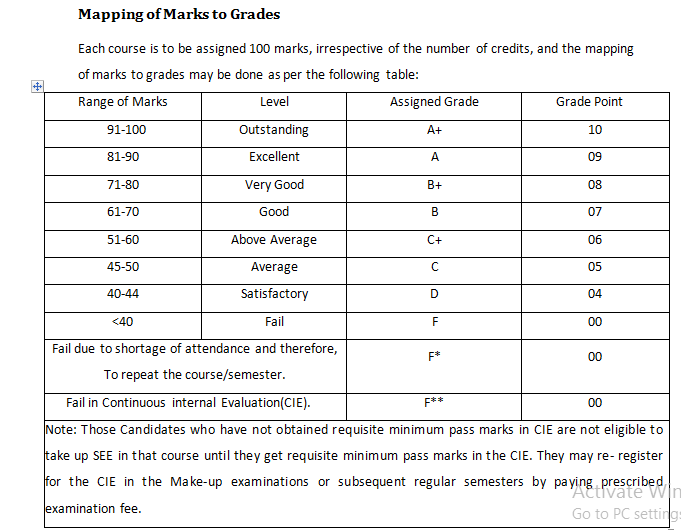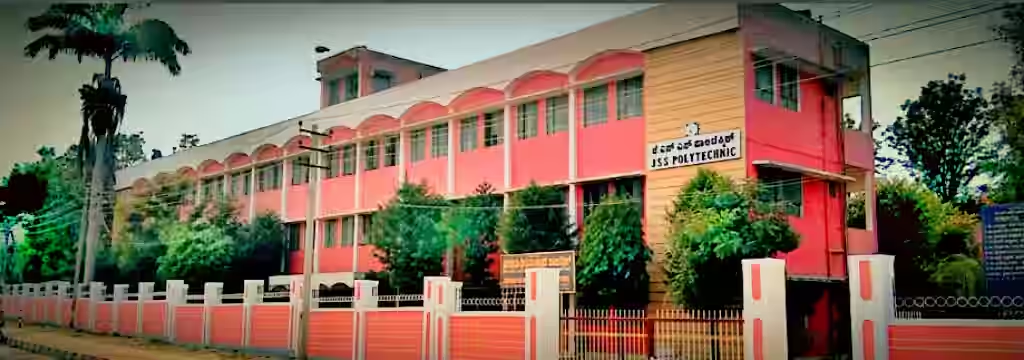| CIE |
| The Continuous Internal Evaluation for theory/theory-practice / project work etc; shall be conducted as per assessment methodology prescribed in the curriculum. However additional remedial test may be conducted for absentee students in the subsequent week of respective assessment for which he/she is absent. The Blue Books shall be signed by the student and the concerned faculty & Head of Section / Principal and kept in the custody of Principal. Blue books should be preserved in the institution as per the BTE norms. |
| Evaluation and Assessment Scheme |
|
1. In Theory course, the weightage of Continuous Internal Evaluation (CIE) is 50% and for Semester End Exam (SEE)
is 50%. The student has to obtain minimum of 40% marks individually both in CIE and SEE to pass. However Semester
End Exam (SEE) is conducted for 100 marks (3 Hours duration). 2. In Practical course, the weightage of Continuous Internal Evaluation (CIE) is 60% and for Semester End Exam (SEE) is 40%. The student has to obtain minimum of 40% marks individually both in CIE and SEE to pass. However Semester End Exam (SEE) is conducted for 100 marks (3 Hrs duration). Grading will be awarded based on both CIE and SEE assessments. 3. The Continuous Internal Evaluation (CIE) is based on the student’s performance in Internal Assessment tests, Skill tests, Multiple choice questions, Open book tests, Student activity, Mini project, Quizzes, Assignments, Seminars, Viva-voce in practical, lab record etc as specified in respective course curriculum. 4. For Internship / Projects / Seminar etc. Evaluation is based on work done, quality of report, performance in viva-voce, presentation etc |
| About SEE |
| End Semester Examination means the examination to be held at the end of each semester separately for theory and practical part on such dates as the College may determine. End Semester Examination means an examination conducted on a date fixed by the DTE at the end of each semester. |
| Credit Based System |
| A credit system is a systematic way of describing an educational program by attaching credits to its components. The definition of credits in higher education systems may be based on different parameters, such as student workload, learning outcomes and contact hours. |
| Grade and Grade Points |
| Grading in education is the process of applying standardized measurements for varying levels of achievements in a course. Grades can be assigned as letters (usually A to F), as a range (for example, 1 to 6), as a percentage, or as a number out of a possible total. |
| Mapping of Marks to Grades |

|
| SGPA and CGPA Calculations |

|
| Diploma C-20 Syllabus Regulations GO |
|
https://dtek.karnataka.gov.in/storage/pdf-files/C20%20syllabus/C20%20Diploma%20Regulations%20GO.pdf |

Sri. N Vidyashankar
Principal
9886618231

Sri. Shashidhar K
Superintendent
9880534739

Smt. Ramya
SDA
7892210152
| Sl.No | Name | Designation | Contact |
|---|---|---|---|
| 1 | Sri. N Vidyashankar | Principal | 9886618231 |
| 2 | Sri. Shashidhar K | Superintendent | 9880534739 |
| 3 | Smt. Ramya | SDA | 7892210152 |
Course Offered & Intake
| Sl.No. | Programs | Intake(Inc SNQ) |
|---|---|---|
| 1 | Electronics & Communication Engineering | 40+2=42 |
| 2 | Mechanical Engineering | 40+2=42 |
| 3 | Civil Engineering | 60+3=63 |
| 4 | Mechatronics Engineering | 60+3=63 |
| 5 | Electrical & Electronics Engineering | 60+3=63 |
| 6 | Computer Science & Engineering | 60+3=63 |
Admission Details
| Sl.No. | Programs | 2021-22 | 2022-23 | 2023-24 | 2024-25 |
|---|---|---|---|---|---|
| 1 | Electronics & Communication Engineering | 42 | 42 | 42 | 42 |
| 2 | Mechanical Engineering | 42 | 41 | 42 | 42 |
| 3 | Civil Engineering | 27 | 61 | 61 | 48 |
| 4 | Mechatronics Engineering | 30 | 62 | 63 | 57 |
| 5 | Electrical & Electronics Engineering | 24 | 63 | 62 | 63 |
| 6 | Computer Science & Engineering | 28 | 63 | 63 | 63 |
-
Address
Mysore-Ooty Road Nanjangud
-
Contact Number
08221 – 22649 +91 988661823 -
Email;
jsspn324@gmail.com

